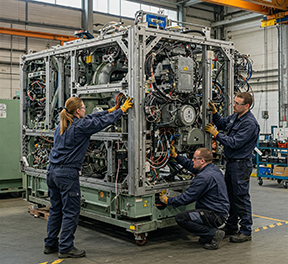Published: June 22, 2015 | Updated: April 10, 2025
Published: June 22, 2015 | Updated: April 10, 2025
Mastering Facility Layout: A Comprehensive Guide to Space Allocation
The Foundational Importance of Space Allocation in Facility Management
 Embarking on a new facility venture, upgrading an existing space, or even constructing a property from the ground up demands meticulous attention to numerous details. Among these crucial considerations, space allocation rises as a fundamental element, particularly during the initial budgeting phase. In this article, we'll discuss the foundational importance of space allocation in facility management.
Embarking on a new facility venture, upgrading an existing space, or even constructing a property from the ground up demands meticulous attention to numerous details. Among these crucial considerations, space allocation rises as a fundamental element, particularly during the initial budgeting phase. In this article, we'll discuss the foundational importance of space allocation in facility management.
Facility managers must proactively address core questions: How much area does each department genuinely require? Where will essential equipment reside? These inquiries represent the starting point for effective space allocation planning.
For facility managers and maintenance supervisors deeply involved in the reliability sector, the significance of thoughtful space allocation within a building resonates strongly. Indeed, every component, every piece of equipment, and every operational zone necessitates a designated place. Regrettably, much like financial resources, spatial resources possess inherent limitations. The ideal scenario of unlimited space rarely materializes; in fact, organizations often grapple with insufficient square footage. This reality underscores the critical role of comprehensive space allocation planning.
The Interplay of Equipment, Personnel, and Workflow
Diligent planning, of course, is the starting point for effective equipment placement. Merely providing adequate room for machinery to stand and function represents only one facet of the equation. We must also account for the operational space workers need to interact with the machinery, conduct necessary maintenance, and even navigate around it safely.
The absence of clearly defined workspaces and walkways can lead to operational bottlenecks and compromise worker safety. Consequently, production rates can suffer. These negative outcomes demand careful consideration within the space allocation framework.
Shifting focus to safety, you have a top issue of fire hazards. In the event of a fire, do you have unobstructed exit routes and sufficient space for employee evacuation? Furthermore, emergency responders require adequate room to effectively combat the fire. The strategic placement of fire extinguishers and fire alarms, coupled with well-designed ventilation systems, all consume space that might not initially come to mind during planning. Facility managers must plan these safety considerations in their space allocation strategies.
Certain types of machinery generate substantial heat and should never be situated near flammable chemicals or materials. Therefore, meticulous planning of the necessary clearance between walls and other equipment becomes essential to mitigate fire risks. A similar principle applies to those hazardous chemicals. Establish dedicated storage areas for these chemicals and associated cleanup supplies.
Cultivating Employee Well-being Through Thoughtful Design
Another crucial element, often not immediately at the forefront of facility managers' concerns, involves the comfort and well-being of employees. This is not to suggest a lack of care; rather, reliability managers often prioritize equipment and customer needs.
However, allocating property space for break rooms and restroom facilities proves equally vital, as does strategically determining their optimal locations. The farther an employee must travel to reach a restroom, the longer their break inadvertently becomes. Conversely, positioning a break room too close to the primary workspace can diminish its intended purpose as a relaxing sanctuary where employees can mentally detach from their tasks, even briefly.
Discover how streamlined maintenance processes can elevate production. Learn more.
The Strategic Advantage of a Computerized Maintenance Management System (CMMS) in Space Management
If your organization currently employs a computerized maintenance management system (CMMS)—and at this stage of facility management evolution, it ideally should—this technology can significantly simplify the space allocation process. A CMMS provides a comprehensive visual overview of all assets and equipment within the facility. This holistic perspective empowers facility managers to make more informed decisions regarding spatial arrangements.
Beyond visualization, a CMMS contributes to space conservation. By enabling the digital storage of documents and other critical information directly within the system, organizations can reduce the need for physical storage, thereby reclaiming valuable square footage. This shift towards digital record-keeping minimizes clutter and enhances overall organization within the facility.
Furthermore, a CMMS plays a pivotal role in the efficient management of spare parts and replacement components. The system facilitates the accurate tracking of these items, allowing for the centralization of their storage. This centralized approach not only makes retrieval faster and easier but also contributes significantly to maintaining a tidy and well-organized workspace. Knowing the precise location and quantity of each spare part prevents unnecessary accumulation and inefficient use of storage areas.
 The detailed records within a CMMS offer another layer of spatial insight. Maintenance history associated with specific equipment can reveal the frequency and nature of required access for repairs. This information proves invaluable when determining appropriate clearances and ensuring sufficient workspace around machinery for maintenance personnel. By understanding the operational and maintenance demands of each asset, facility managers can allocate space more effectively, preventing future access issues and potential safety hazards.
The detailed records within a CMMS offer another layer of spatial insight. Maintenance history associated with specific equipment can reveal the frequency and nature of required access for repairs. This information proves invaluable when determining appropriate clearances and ensuring sufficient workspace around machinery for maintenance personnel. By understanding the operational and maintenance demands of each asset, facility managers can allocate space more effectively, preventing future access issues and potential safety hazards.
Consider the implications for future expansions or modifications. A well-maintained CMMS provides a historical record of asset locations and space utilization. This data becomes instrumental in planning for new equipment installations or reconfigurations of existing layouts. Facility managers can analyze past space usage patterns to anticipate future needs and avoid costly mistakes in space allocation during expansion projects. The ability to access this historical data allows for better-informed decisions, leading to more efficient and sustainable space planning.
Moreover, a CMMS often includes features for generating reports and analytics related to asset performance and maintenance activities. These reports can indirectly inform space allocation decisions. For example, frequently failing equipment might necessitate more accessible placement for easier maintenance or even relocation to a less critical area to minimize production disruptions. The insights gained from CMMS data can lead to a more dynamic and responsive approach to space management, adapting to the evolving needs of the facility.
The integration of a CMMS with other building management systems can further enhance space allocation effectiveness. Some systems have built-in capabilities, while others would need assistance from the provider for integration. For instance, linking the CMMS with sensor data on environmental conditions around equipment (temperature, humidity) can inform decisions about optimal placement to prolong equipment life and prevent potential hazards. This interconnectedness provides a more comprehensive understanding of the facility's operational environment and its impact on space requirements.
In essence, a CMMS transcends its primary function of maintenance management to become a powerful tool for strategic space allocation. It provides the data, the visualization capabilities, and the organizational framework necessary for facility managers to make informed decisions that enhance efficiency, safety, and overall operational effectiveness. Embracing a CMMS represents a significant step towards proactive and intelligent space management within any modern facility.
Beyond the Blueprint: The Enduring Impact of Space Allocation
The meticulous planning of space within a facility extends far beyond the initial layout. It establishes a foundational framework that influences daily operations, employee morale, and the long-term adaptability of the organization. The decisions made during space allocation resonate through the years, shaping the very fabric of how work gets done and how the facility evolves to meet future demands. Thoughtful space allocation is not merely an exercise in drawing lines on a blueprint; it is an investment in the future functionality and success of the enterprise.
Mapcon / 800-922-4336
MAPCON CMMS software empowers you to plan and execute PM tasks flawlessly, thanks to its wealth of features and customizable options. Want to see it for yourself? Click the button below to get your FREE 30-day trial of MAPCON!
Try It FREE!